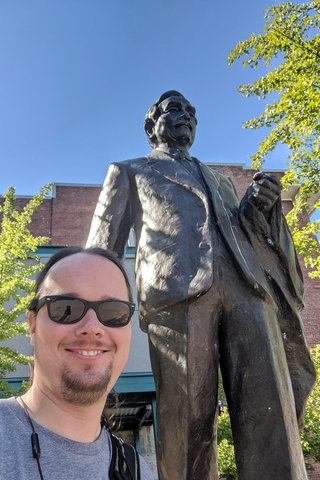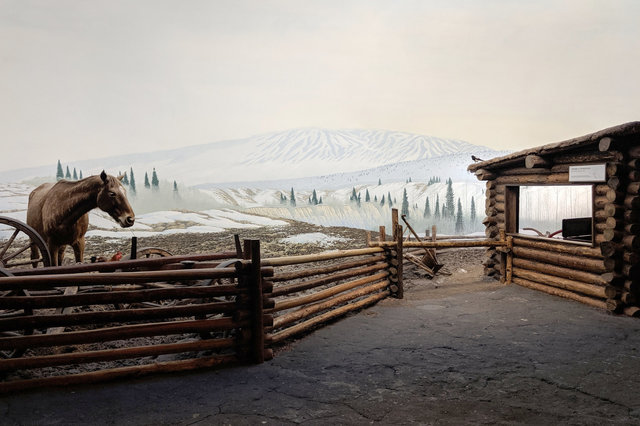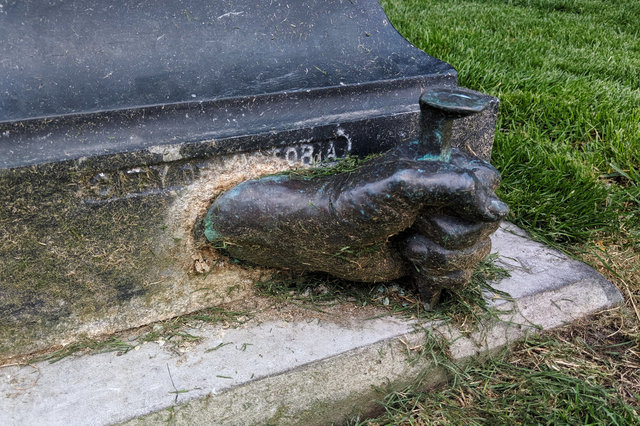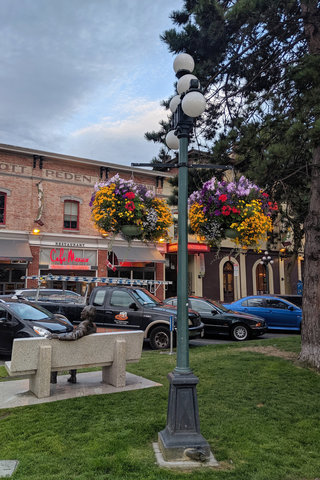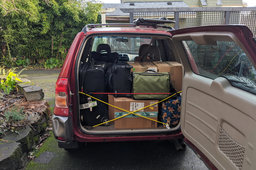Victoria
Started: 2019-08-11 14:39:50
Submitted: 2019-08-11 23:54:18
Visibility: World-readable
26 July 2019: In which the intrepid narrator learns First Nations history, walks along a breakwater, and visits a castle
Victoria, it turned out, has a large supply of cute cafes with vegetarian-friendly breakfast menus, to the point where I took entirely too long to pick where to eat breakfast. I eventually walked to Mo:Lé Restaurant, a half-mile from my hotel, past the boats docked at the inner harbour, across from the Empress Hotel.
(In case you're wondering, when I crossed the border I was issued a supply of extra letters "u" to use in order to localise my spellings into the local dialect of English. I am amused that I can visit another country where my appearance and accent do not immediately identify me as a foreigner. As soon I crossed the border I switched to my chip-and-pin credit card, saving me (and the merchants I interacted with) from the indignity of using Ugly American chip-and-signature cards.)
I sat in the window booth at Mo:Lé Restaurant, which turned out to be a delightful cafe, and enjoyed my breakfast.
I discovered that I was on the outskirts of Victoria's small Chinatown, so I dropped by the Chinatown gate -- and then found, in a square opposite the gate, a statue of Sun Yat-Sen.
After breakfast, I headed towards the Royal British Columbia Museum but got sidetracked by a large sign reading "Canada" that was apparently set up by the local tourism board to feature in photos on social media.
On my way to the museum I stopped by the museum's clocktower, which was just wrapping up its hourly chime, to photograph the spiral staircase climbing to the bells at the top of the tower. (Well actually, it's a helix.) The framing of the stairs in the open reinforced concrete tower looked vaguely familiar; I had, in fact, taking an almost-identical picture of the staircase seventeen years ago, the last time I visited Victoria.
The first thing I learned inside the Royal British Columbia Museum was that, in French, the province of British Columbia is "Colombie-Britannique". With that odd little bit of linguistic trivia I headed up the escalators to the First Nations gallery on the third floor and spent the next two hours learning about the cultural heritage of the people who were here before Europeans showed up. I found interesting the displays on orthographies used to write First Nations languages -- not only do the languages use phonemes not present in English, but the various languages do not even use the same graphemes to represent the same phonemes.
The centerpiece of the collection was a room full of totem poles, mostly Haida, including some used as house entry posts, with openings large enough to function as doors in the middle of the pole.
After the First Nations gallery, I looked through the British Columbia history gallery, covering the gold rushes, mining, and farming in the territory, and the construction of the Trans-Canada Railroad.
One of the displays showed the implements of "modern agriculture" (from the 1920s to 1970s), which I interpreted as a shout-out to my own Western Canada ancestors: my Goerlitz great-grandparents, who farmed in Acme, Alberta until 1966 then moved to Kelowna, BC on a little retirement farm where I visited them as a kid in 1986.
Then I noticed the diorama opposite the display, which depicted the Tremblay farm in the Peace River Valley. I have no idea if I'm related to this branch of the Tremblay family; but a branch of my family tree did come from Quebec in the second half of the nineteenth century (at which point they anglicized their name to "Tramblie"). So I assume that anyone named Tremblay is a distant cousin of mine.
The last thing I saw in the museum was a series of display cases showing the twentieth century, including a section devoted to Expo 86, the world's fair which I visited as a five-year-old. I didn't miss Expo 86 -- I was there.
I ate lunch at the museum's cafe, then headed out on an extended walk along the harbour, circumnavigating the neighborhood of James Bay, on a peninsula immediately south of the harbour. The route took me past leafy residential suburbs, past a colorful houseboat community, past the sprawling cruise ship terminal at the mouth of the harbour, to a breakwater protecting the mouth of the harbour.
The breakwater had a large concrete path, protected by a modern railing, on the top leading out to a lighthouse marking the entrance to the harbour. (The breakwater and lighthouse were present when I visited Victoria in 2002, according to the photo I took, and it was clearly used as a walkway, but the railing protecting the edges of the path were new.)
From the breakwater I could look across the Straight of Juan de Fuca to the Olympic Mountains. As I watched, the vehicle ferry MV Coho cruised out of the harbour to make the international journey across the straight to Port Angeles. (Coho is the leftmost ship visible on the horizon in the picture below.)
From the top of the breakwater I could see one of the cruise ships docked at the cruise ship terminal, Norwegian Joy. Kiesa was, at that moment, on another cruise ship somewhere in Alaska's Inside Passage, and would be docking at Victoria the following evening.
The breakwater was built on a series of large granite blocks, each more than a meter square, dry-stacked on top of each other in the open water. The railing included a couple of flights of stairs leading from the path on top of the breakwater to the blocks, providing an alternate route back to land.
I took the stairs and walked along the outside of the breakwater, occasionally feeling one of the granite blocks shift under my feet as the waves washed against the blocks.
Back on land, I continued walking east, along the water, past small beaches and rocky cliffs opposite residential neighborhoods. (At one point I saw a deer and fawn in someone's front yard.) I stopped at the edge of Beacon Hill Park to photograph the Mile Zero Monument officially marking the start of Canada's highway mileage (though we were on an island off the coast of the mainland, so any highway mileage would have to take the ferry route into account).
Elsewhere in the park I saw the world's tallest totem pole, an elaborately-painted wooden pole mounted on a concrete base using a steel mount. I found it difficult to appreciate the totem pole from the ground, since I could only see a small portion of its full height up close.
From the park I walked to Craigdarroch Castle, a mansion built at the end of the nineteenth century by a coal baron (who died before he got a chance to live there). The construction house was made possible by the new continent-spanning rail network, connecting British Columbia to the rest of Canada and the entire United States, allowing Dunsmuir to hire craftspeople and import finishings from the entire continent. His family lived in the house, and then the house was occupied by a military hospital, Victoria College, a school board, before finally finding itself in the hands of a historical society that restored the castle and let tourists lose in the house.
Being one such tourist, I picked up an interpretive map and walked into the main entrance for the briefing, then began to wander through the house. The first thing I noticed was the wood-paneled staircase going up four flights of stairs through the house.
Many of the rooms in the house had been restored to their original Victorian appearance during the period when the Dunsmuir family lived in the house. Others were presented as they had been used at various other points during the house's history.
The entire house gave the appearance of a palimpsest, with each era of modifications only partially obscuring those that came before it. Some of the rooms were presented empty, with signs explaining what the architectural historians thought the room had been used for from the clues they could find. Some of the empty rooms included pictures from other preserved historic houses from the same time period, giving an idea of what it might have looked like.
The very last room in the museum was the old kitchen, stripped bare of all of its essential nature except for patches of backsplash still mounted to the walls. The historical society had a person sitting at a table who asked if I had any questions, and I had none, having just spent the better part of hour wandering the house and drinking from the firehose of history.
When I emerged from the castle, blinking in the bright evening sun, it was time for supper. I walked around the house, looking over the remains of the grounds, and marveling at the mansion, clearly built to last but with a very different idea of what a house ought to be.
I walked back to central Victoria, nestled against the inner harbour, and ate pizza for supper. On my way back to my hotel I noticed, in a little pocket park in a tiny street median next to one of the main roads entering the city centre, a life-sized sculpture of a hand sticking out from the bottom of a lamp post holding a railroad spike.
The lamppost gave no indication what the sculpture was supposed to be, leading me to speculate as I headed back to my hotel for the night.


